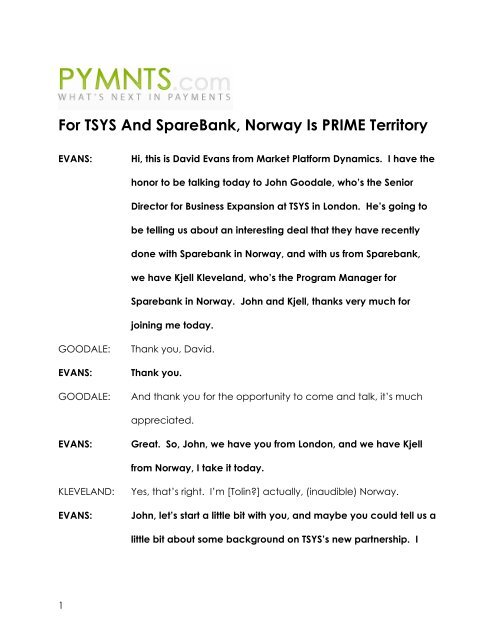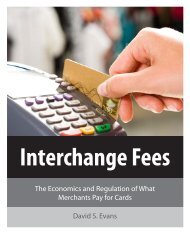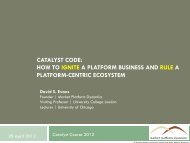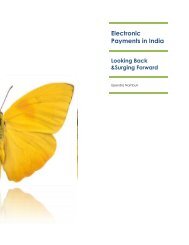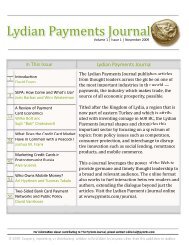For TSYS And SpareBank, Norway Is PRIME Territory - PYMNTS.com
For TSYS And SpareBank, Norway Is PRIME Territory - PYMNTS.com
For TSYS And SpareBank, Norway Is PRIME Territory - PYMNTS.com
- No tags were found...
You also want an ePaper? Increase the reach of your titles
YUMPU automatically turns print PDFs into web optimized ePapers that Google loves.
<strong>For</strong> <strong>TSYS</strong> <strong>And</strong> <strong>SpareBank</strong>, <strong>Norway</strong> <strong>Is</strong> <strong>PRIME</strong> <strong>Territory</strong>EVANS:Hi, this is David Evans from Market Platform Dynamics. I have thehonor to be talking today to John Goodale, who’s the SeniorDirector for Business Expansion at <strong>TSYS</strong> in London. He’s going tobe telling us about an interesting deal that they have recentlydone with Sparebank in <strong>Norway</strong>, and with us from Sparebank,we have Kjell Kleveland, who’s the Program Manager forSparebank in <strong>Norway</strong>. John and Kjell, thanks very much forjoining me today.GOODALE:EVANS:GOODALE:Thank you, David.Thank you.<strong>And</strong> thank you for the opportunity to <strong>com</strong>e and talk, it’s muchappreciated.EVANS:Great. So, John, we have you from London, and we have Kjellfrom <strong>Norway</strong>, I take it today.KLEVELAND:EVANS:Yes, that’s right. I’m [Tolin?] actually, (inaudible) <strong>Norway</strong>.John, let’s start a little bit with you, and maybe you could tell us alittle bit about some background on <strong>TSYS</strong>’s new partnership. I1
understand that it involved a product line that <strong>TSYS</strong> has called“Prime”. So maybe tell us a little bit about that.GOODALE:Yes, well, we were delighted to announce last week the dealthat we struck with [Spare?] (inaudible). <strong>And</strong> it’s corrected toour Prime license family of products, and what the Prime solutionis, Prime Four in this particular case, it provides both a card issueand an acquiring capability for our clients, and it’s beenadopted by many clients across the world. We’ve got over ahundred clients that use it now in around 70 countries. <strong>And</strong> Ithink one of the reasons why it’s particularly interesting for <strong>TSYS</strong> asa product, is it fits very nicely for those clients, in particular thoseregions in the world, whether for their own individual clientreasons, or maybe for specific regulatory reasons in certainareas. It provides a capability to those clients to manage theirown solution with that particular license capability. So, a lot ofpeople associate <strong>TSYS</strong> with processing services, which of course,we’ve done for a number of years. But I think, less peoplemaybe consider it for processing -- sorry, for licensing. But ofcourse, with a hundred odd clients, there’s significant licensecapability that we have, and that is supported through thatPrime family.2
So in this case, it’s the Prime Four solution, and as per theinformation in the press release, for supporting the MasterCardand Visa issuing requirements that Sparebank one have, whichcover their -- their credit charge, prepaid and contact listrequirements.EVANS:GOODALE:John, how long has <strong>TSYS</strong> been active in <strong>Norway</strong>?Well, in <strong>Norway</strong>, we’ve been active for 15 years. But I canactually sort of expand that question a little bit more to coverthe whole of the Nordics, which is really quite a strong region for<strong>TSYS</strong>, particularly in licensing by itself. <strong>And</strong> actually, we’ve got avery strong share that we’ve built up since that first client wentlive in <strong>Norway</strong> in 1997, to a point now where something like thetop -- seven of the top ten banks use prime as a licensed solutionwithin their business. So for us, it’s been a very strong, successfultrack record, from that initial -- say initial set-up in <strong>Norway</strong>, all theway through, across the whole of the -- what is a very importantNordic market for us. Mainly an issue, but not only consumercards, but also <strong>com</strong>mercial cards, because, they all on thatPrime platform.What I will just say, because I think it’s an important part of this, isthe -- this, sort of success that we had is based on that initial3
Norwegian client back in 1997, was, I think sort of supplementedby a very important piece of work we did with DnB NOR, whowere the market leaders in <strong>Norway</strong>, who announced, who had a2.2 million card conversion in 2010. So I think that that sort ofmoved it from an initial market entry through to a very dominantposition within the market.EVANS:Kjell, maybe you could tell us a little bit about how theNorwegian banking environment differs from that in the US. Iassume to being with that you don’t have the 15,000 banks thatwe have here.KLEVELAND:That is correct. <strong>And</strong> I don’t consider myself as an expert aboutthe US market. But of course, the most obvious difference in thevolumes. The volumes are much, much lower. Creating lowvolumes, ultimately, that we have to need, or you have to keepaway some focus on operating costs (inaudible). In <strong>Norway</strong>, weare about 4 million adults. The card -- credit card market in<strong>Norway</strong> always, is very mature. In total card market though, 12million cards, meaning that you have approximately three cardsper woman -- per adult in <strong>Norway</strong>.EVANS:KLEVELAND:Mm-hmm.What would be 12 million? Five million sounds very good. Tenissuers are controlling more than 95% of the Norwegian credit4
care market. <strong>For</strong> the <strong>com</strong>ing year, Sparebank aims to actuallybe on the second or third position when it <strong>com</strong>es to issuing,because the Norwegian credit card market is very much aboutissuing, and not about acquiring, as we have a situation that,[met?] operators owned by the bank control almost 80% of theacquiring market.EVANS:Mm-hmm, very interesting. Kjell, how was <strong>TSYS</strong> able to meetSparebank One’s needs -- specific needs, with regard to thispartnership?KLEVELAND:Yeah, what was that important to us, on -- we had three keyfactors in our (inaudible)-ation process, that was system flexibility,integration technology, and the vendors ability to deliver. InJune 4, 2011, [Seranguom?] initiated a [power plant?],(inaudible) picking up a credit card <strong>com</strong>pany, that is fromscratch. <strong>And</strong> aim actually to go on to the pilot product inNovember 2013. <strong>And</strong> (inaudible) everybody, limited time frame.<strong>And</strong>, causing this limited time frame, the ability to deliver into theNorwegian market, for the very, very important (inaudible) for us,(inaudible) generation. In addition to that, you also see that theplayers in the Norwegian market, and the market itself, and itacquires user-friendly, and (inaudible) services distance, and toprovide it to the markets, and through different channels. <strong>And</strong>5
ecause of this, the integration technology, and (inaudible)ability to actually adapt the different technologies, it was veryimportant to us.EVANS:That’s very helpful, Kjell. John, you said Prime has an extensivefootprint globally, surveying financial institutions. I don’t thinkyou mentioned this, but my understanding is it serves financialinstitutions in more than 70 countries. <strong>Is</strong> that correct?GOODALE:It is, it is. <strong>And</strong> I think those words are very accurate, the extensiveglobal footprint is a great description for it. When I first came --started working with Time, probably six, seven years ago now -- it-- the thing that struck with me was that diverse geographicrange, literally everything from South America, across Europeand Africa, all the way to large parts of Asia. The platform isused in the same form. Obviously, for different purposes. We’vegot issue that requires different product types, and what haveyou, (inaudible). But the other piece, I think, that’s really quitestriking about it, is the range of sizes of potential clients. We’vegot people that are using it, literally just a few thousand cards,but are using the same system for -- and others who are using thesame system for their -- multiple millions of cards, and supportingvery, very different needs from those products itself.6
I think, the other thing for us, has made a big difference from<strong>TSYS</strong> perspective has made a big difference, and a biginfluence, is our own use of the product. We also use Prime forourselves, in our own process environment, and we recentlyannounced the <strong>com</strong>pletion of the Carrefour portfolio conversionin Brazil, which I think covers some 13 million cards. <strong>And</strong> it’s allbased on exactly the same core Prime Four platform, that we’reimplementing here with Sparebank One. So, to me, the biggestimpact is on the range of clients that are able to leverage thecapability of Prime and Prime Four in particular, but also, ourability as <strong>TSYS</strong> to use it in our environments, at our own(inaudible) to meet our expansion requirements (inaudible).EVANS:John, let’s turn back to the Norwegian situation just for a second.In the release announcing the partnership with Sparebank One, itsays that Norwegian banking needs are evolving. Maybe youand perhaps Kjell if he wants to chime in as well, could speak alittle bit about how they’re evolving a way that’s important for thispartnership and for the use of Prime? So John, why don’t youtake this first.KLEVELAND:GOODALE:Yeah.OK, well I think the -- particularly, the evolving requirementsaround <strong>Norway</strong>, I think from my perspective, it’s important that7
the people understand how the requirements in <strong>Norway</strong> aremaybe different from other requirements in Europe, and I think itshould be seen through those lights as well. The regulatoryrequirements in <strong>Norway</strong> are different. It’s not part of the EU.There are some very stringent data protection requirements andother elements as well that dictate the type of solution, and theway that that particular solution is implemented that somethinglike Prime and the flexibility around Prime has to support. So Ithink, having the context and the understanding about the factthat <strong>Norway</strong> itself is a quite different market, and say has somedifferent regulatory constraints around it is important for thebackground to understand.EVANS:KLEVELAND:Kjell, do you have anything to add to that?No, I think, John actually did a (inaudible). What you also see isthat the market is evolving with new product characteristics. As,the market is very <strong>com</strong>petitive, and you see that several ofvendors now are <strong>com</strong>bining credit card products with otherfinancial products, (inaudible) insurances.EVANS:KLEVELAND:Mm-hmm.<strong>And</strong> of course, you have this adaption to new technology,(inaudible) etc., etc. So we are in a changing time. <strong>And</strong> youalso see that it’s important actually to be an association system,8
and system-wise, (inaudible) have this flexibility. <strong>And</strong> able toactually have a short time to market.EVANS:Kjell, that’s very helpful. Thank you very much for that answer.John, what’s next for <strong>TSYS</strong> on international front?GOODALE:Yeah, well <strong>TSYS</strong> is very reactive internationally. I think we’ve hada lot of developments over the last few years which we’re verypleased with. I think we’re up to 150 clients, in say 75-oddcountries, and about 2000 team members now in international.Right around 12 or so locations. So for us, I think the mostimportant thing is to -- is to build out on that expansion thatwe’ve done. I mentioned Carrefour earlier down in Brazil. Bigopportunity, obviously, in Brazil as a market, so I think growing inBrazil is a big, big piece of that. Here in Europe, we need to doscale. We have entered three new countries in the last 12-18months. Switzerland, Italy, and Luxembourg. We need to buildout on those, and obviously build on that investment that we’vemade. We see a very strong interest in cross-border, particularlyamongst European issuers who are looking --EVANS:GOODALE:Mm-hmm.-- trying to consolidate our systems. So we see again, bigopportunities around how the banks themselves can grow, butbe supported more importantly by software solutions to meet9
their growth. <strong>And</strong> I think for us, when it <strong>com</strong>es back to the, sortof, “where next,” we have to look at the -- all the countries we’rein beside, OK, well what are the next logical countries to go into?So we’re looking at those, and we’re looking to see whatpropositions can we add to our, what we call our existing homemarkets, those markets where we have already a strong marketshare? We’re looking at debit propositions, we’re looking atretail propositions. <strong>And</strong> also, we’re looking very heavily at howwe can take the global product developments that we’remaking, things like the collected mobility work that we’re doingat the moment, and make and then, bringing those to marketfor our clients over here in Europe and international item.EVANS:John, thank you very much. John and Kjell, this is veryinformative. It sounds like a very interesting partnership you guyshave, and we really appreciate the time you spent with thosetoday. So have a great rest of the day, and thanks again.GOODALE:KLEVELAND:Thank you, Dave. Appreciate it.Thank you.10


